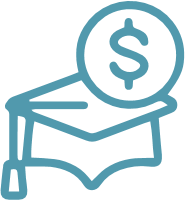FINANCIAL AID FOR HIGHER EDUCATION

If you and your family have saved some of the money you need to pay for your child’s education, but still need more, there may be a solution. It’s called financial aid.
There are several kinds of financial aid. To keep things simple, let’s divide it into three main categories:
First, there’s money that’s given to you that you don’t have to pay back, like grants and scholarships. Second, a student earns money by working part-time, usually on campus. This is called the Federal Work-Study program. The third category is the money you borrow. These are loans that you must repay. Student loans are available from three primary sources: the U.S. federal government, state governments, and financial institutions, like banks. Some families also use home equity loans to help pay for education expenses.
Financial aid — the combination of money you receive, money you earn, and money you borrow — all added to the money you save — can make it possible for you to pay the cost of higher education, whether that’s at a college, community college, trade school, or technical school.
HOW MUCH YOU’LL NEED FOR SCHOOL
Average yearly cost at a 4-year college
A 2020-21 College Board study* showed that the average yearly cost (tuition, room and board, and fees) of attending a private college or university for one year was $50,770. The average annual cost at public universities was $22,180 for in-state students and $38,640 for out-of-state students. It makes sense to start saving as much as you can as soon as you can.
Why costs vary
The amount of money you’ll need for school depends on many factors, such as the school you choose, whether it’s public or private, whether you’ll be completing a 2-year or 4-year program, and whether you’re going to be living at home or school. The total price tag can vary significantly.
COA: A simple way to compare costs
Most two-year and four-year colleges calculate a Cost of Attendance (COA) figure to show the total cost of full-time education for one academic year. It includes the average price of instruction, known as tuition; fees, books, and supplies; and housing and meals, also referred to as room and board. Contact any school that interests you and ask about its tuition and fees.
Other factors to consider
Money’s not the only factor to consider when comparing schools. The fact that one school costs more than another doesn’t guarantee that the quality of education will be better. Consider other factors, such as which school has the stronger program in your favorite subjects, which one has a better reputation, and which has the kind of environment you think you’d enjoy.
*https://research.collegeboard.org/trends/college-pricing

ALL ABOUT FINANCIAL AID for higher education
Financial aid encompasses a range of resources, including grants, work-study programs, loans, and scholarships, designed to support higher education. There are various types of financial aid available to help students.
Grants and Scholarships
Federal Student Loan
Private Student Loan
Work-Study

HOW TO APPLY FOR FEDERAL STUDENT LOANS
The Free Application for Federal Student Aid (FAFSA) is the first step in applying for federal financial aid. You and your family should fill out the FAFSA, regardless of whether you think you qualify for financial assistance or not. Some states and schools use information from the FAFSA to determine your eligibility for their grants, scholarships, and loans.
APPLY ONLINE
Most high school counseling offices can provide you with a paper copy of the application; however, to expedite the process, complete the FAFSA online at www.studentaid.gov.
APPLY EARLY
You need to fill out the FAFSA as soon as possible in your senior year of high school. It’s essential to submit your application as early as possible. Millions of students apply for financial aid every year, and many of the groups that provide funding do so on a first-come, first-served basis. The sooner you apply, the sooner you’ll see your financial aid packages, and the sooner you can make your school decisions and plans. You’ll also have more time to apply for private loans if you need them.
HAVE THESE ITEMS READY
Here is a list of items to have on hand before sitting down to fill out the FAFSA:
- Social Security number for both the student and the parent/guardian
- Driver’s license number
- W-2 forms from the most recent tax year for the student and parents/guardians
- Income tax returns for the most recent year (parents//guardians should file their taxes as early as possible).
- Other financial info, such as any other records of money earned by the child or parent//guardian, bank statements, and investment mortgage information.
- Alien registration card (if not a U.S. citizen)
REAPPLY EACH YEAR
Each year you’re enrolled in higher education, you must reapply for financial aid, since your finances and costs may change. The federal government will send you a Renewal Application for Federal Aid, or a Personal Identification Number (PIN), to apply for federal financial aid online for the next academic year. This information will be mailed to you at your home, so watch for its arrival. If you don’t receive this information, contact your school’s financial aid office.
If you’re a student who works to help support your family, be sure to share this information with your school’s financial aid office. It may make you eligible for more assistance.
HOW MUCH DO I NEED TO BORROW?
It’s important to borrow only what you need to pay for higher education. Remember: a student loan is a long-term commitment, and whatever you borrow, you must pay back—with interest. Excessive borrowing can result in higher payments in the years to come.
Before accepting a loan, it is essential to understand the terms you are agreeing to. Use this checklist to research the loan before you accept it:
- Rates and Fees
- The length of the repayment period
- Your rights and responsibilities as a borrower
- Ability to make payments while in school
Be realistic about what your salary might be after graduation and estimate the amount of debt you can afford. Ideally, student loan payments should be ten percent or less of your net monthly income.
Before you borrow, explore all your financial aid options, focusing first on scholarships and grants that don’t have to be repaid.
MANAGING YOUR FINANCIAL AID
If you’ve received grants, scholarships, and student loans, it’s essential to get the most for your money by spending it wisely. Here are some tips for managing your financial aid:
TRACK YOUR FINANCIAL AID ON THE CALENDAR
KNOW WHAT BILLS TO EXPECT
KEEP TRACK OF YOUR SPENDING
MAKE A WRITTEN BUDGET
EXERCISE CREDIT CARD CAUTION
KEEP APPLYING FOR AID
For more information, visit: Financial Aid for Higher Education – Hands on Banking.
